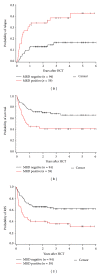Impact of minimal residual disease, detected by flow cytometry, on outcome of myeloablative hematopoietic cell transplantation for acute lymphoblastic leukemia
- PMID: 24778882
- PMCID: PMC3981457
- DOI: 10.1155/2014/421723
Impact of minimal residual disease, detected by flow cytometry, on outcome of myeloablative hematopoietic cell transplantation for acute lymphoblastic leukemia
Abstract
In this retrospective study, we evaluated the impact of pre- and posttransplant minimal residual disease (MRD) detected by multiparametric flow cytometry (MFC) on outcome in 160 patients with ALL who underwent myeloablative allogeneic hematopoietic cell transplantation (HCT). MRD was defined as detection of abnormal B or T cells by MFC with no evidence of leukemia by morphology (<5% blasts in marrow) and no evidence of extramedullary disease. Among 153 patients who had pre-HCT flow data within 50 days before transplant, MRD pre-HCT increased the risk of relapse (hazard ratio (HR) = 3.64; 95% confidence interval (CI), 1.87-7.09; P = .0001) and mortality (HR = 2.39; 95% CI, 1.46-3.90, P = .0005). Three-year estimates of relapse were 17% and 38% and estimated 3-year OS was 68% and 40% for patients without and with MRD pre-HCT, respectively. 144 patients had at least one flow value post-HCT, and the risk of relapse among those with MRD was higher than that among those without MRD (HR = 7.47; 95% CI, 3.30-16.92, P < .0001). The risk of mortality was also increased (HR = 3.00; 95% CI, 1.44-6.28, P = .004). These data suggest that pre- or post-HCT MRD, as detected by MFC, is associated with an increased risk of relapse and death after myeloablative HCT for ALL.
Figures


References
-
- Terwey TH, le Duc TM, Hemmati PG, et al. NIH-defined graft-versus-host disease and evidence for a potent graft-versus-leukemia effect in patients with acute lymphoblastic leukemia. Annals of Oncology. 24(5):1363–1370. - PubMed
-
- Bunin N, Johnston DA, Roberts WM, et al. Residual leukaemia after bone marrow transplant in children with acute lymphoblastic leukaemia after first haematological relapse or with poor initial presenting features. British Journal of Haematology. 2003;120(4):711–715. - PubMed
-
- Campana D. Should minimal residual disease monitoring in acute lymphoblastic leukemia be standard of care? Current Hematologic Malignancy Reports. 2012;7(2):170–177. - PubMed
-
- Brüggemann M, Raff T, Kneba M. Has MRD monitoring superseded other prognostic factors in adult ALL? Blood. 2012;120(23):4470–4481. - PubMed
Grants and funding
LinkOut - more resources
Full Text Sources
Other Literature Sources

